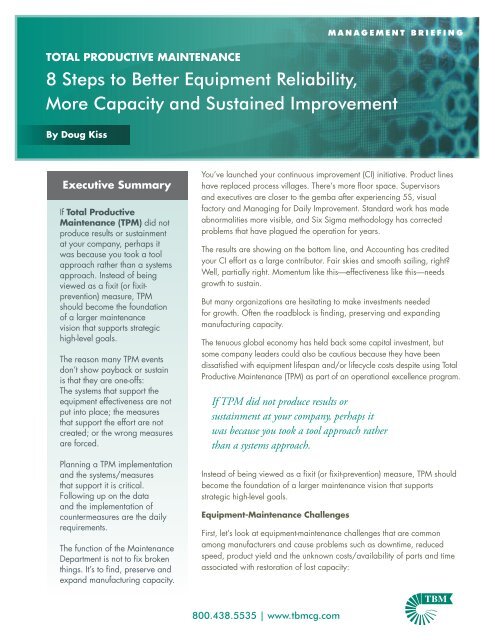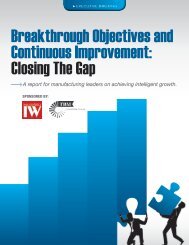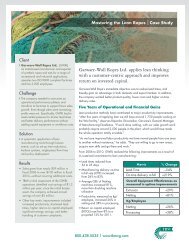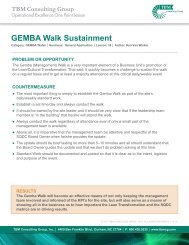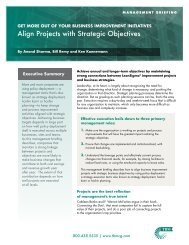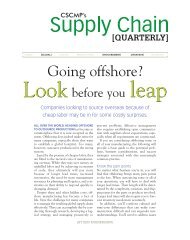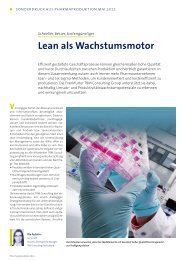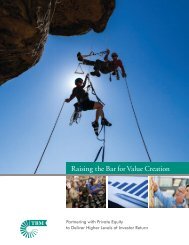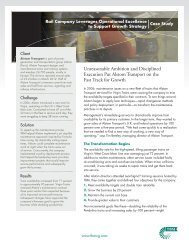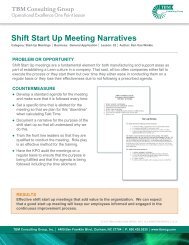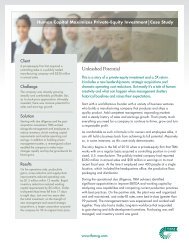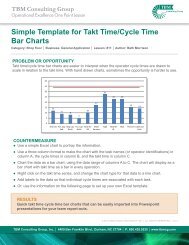Total Productive Maintenance - TBM Consulting Group
Total Productive Maintenance - TBM Consulting Group
Total Productive Maintenance - TBM Consulting Group
You also want an ePaper? Increase the reach of your titles
YUMPU automatically turns print PDFs into web optimized ePapers that Google loves.
M A N A G E M E N T B R I E F I N G<br />
<strong>Total</strong> <strong>Productive</strong> <strong>Maintenance</strong><br />
8 Steps to Better Equipment Reliability,<br />
More Capacity and Sustained Improvement<br />
By Doug Kiss<br />
Executive Summary<br />
If <strong>Total</strong> <strong>Productive</strong><br />
<strong>Maintenance</strong> (TPM) did not<br />
produce results or sustainment<br />
at your company, perhaps it<br />
was because you took a tool<br />
approach rather than a systems<br />
approach. Instead of being<br />
viewed as a fixit (or fixitprevention)<br />
measure, TPM<br />
should become the foundation<br />
of a larger maintenance<br />
vision that supports strategic<br />
high-level goals.<br />
The reason many TPM events<br />
don’t show payback or sustain<br />
is that they are one-offs:<br />
The systems that support the<br />
equipment effectiveness are not<br />
put into place; the measures<br />
that support the effort are not<br />
created; or the wrong measures<br />
are forced.<br />
Planning a TPM implementation<br />
and the systems/measures<br />
that support it is critical.<br />
Following up on the data<br />
and the implementation of<br />
countermeasures are the daily<br />
requirements.<br />
The function of the <strong>Maintenance</strong><br />
Department is not to fix broken<br />
things. It’s to find, preserve and<br />
expand manufacturing capacity.<br />
You’ve launched your continuous improvement (CI) initiative. Product lines<br />
have replaced process villages. There’s more floor space. Supervisors<br />
and executives are closer to the gemba after experiencing 5S, visual<br />
factory and Managing for Daily Improvement. Standard work has made<br />
abnormalities more visible, and Six Sigma methodology has corrected<br />
problems that have plagued the operation for years.<br />
The results are showing on the bottom line, and Accounting has credited<br />
your CI effort as a large contributor. Fair skies and smooth sailing, right?<br />
Well, partially right. Momentum like this—effectiveness like this—needs<br />
growth to sustain.<br />
But many organizations are hesitating to make investments needed<br />
for growth. Often the roadblock is finding, preserving and expanding<br />
manufacturing capacity.<br />
The tenuous global economy has held back some capital investment, but<br />
some company leaders could also be cautious because they have been<br />
dissatisfied with equipment lifespan and/or lifecycle costs despite using <strong>Total</strong><br />
<strong>Productive</strong> <strong>Maintenance</strong> (TPM) as part of an operational excellence program.<br />
If TPM did not produce results or<br />
sustainment at your company, perhaps it<br />
was because you took a tool approach rather<br />
than a systems approach.<br />
Instead of being viewed as a fixit (or fixit-prevention) measure, TPM should<br />
become the foundation of a larger maintenance vision that supports<br />
strategic high-level goals.<br />
Equipment-<strong>Maintenance</strong> Challenges<br />
First, let’s look at equipment-maintenance challenges that are common<br />
among manufacturers and cause problems such as downtime, reduced<br />
speed, product yield and the unknown costs/availability of parts and time<br />
associated with restoration of lost capacity:<br />
800.438.5535 | www.tbmcg.com
P G . 2<br />
• Austerity has forced a general degradation<br />
of equipment condition in the past decade.<br />
The maintenance skills base has eroded due to<br />
attrition, a decline of technical school graduate<br />
availability, and a tendency among companies<br />
to drop maintenance mentoring/apprenticeships.<br />
<strong>Maintenance</strong> departments often lack basic and<br />
specific skills, and few have taken the time to<br />
quantify the gap, let alone plan to bridge it. In<br />
addition, maintenance organizations can lack a<br />
vision and a structure that focuses on effectiveness.<br />
Achieving <strong>Maintenance</strong><br />
Excellence<br />
Autonomous maintenance, preventivemaintenance<br />
optimization, predictive<br />
maintenance, spare-parts inventory, and waste<br />
elimination in maintenance are just a few of the<br />
subjects you may need to address. The most<br />
effective way we’ve found to make rapid and<br />
sustainable change is through TPM improvement<br />
events conducted as part of a plan to achieve<br />
maintenance excellence. Most events are<br />
weeklong, team-based activities focused on a<br />
critical piece of equipment. Teams learn the<br />
theory, specialty tools and methodology and<br />
immediately apply it. They see the benefits<br />
themselves and help to accelerate the process<br />
throughout the facility. The teams report their<br />
accomplishments at week’s end to the process<br />
owners.<br />
Targeted training and workshops ranging<br />
from one to three days are used as needed to<br />
supplement the TPM improvement events. These<br />
include, but are not limited to:<br />
• <strong>Maintenance</strong> manager 101<br />
• Lubrication excellence<br />
• Condition-based maintenance and PM<br />
optimization<br />
• Overall equipment effectiveness<br />
The last step is to periodically set new milestones.<br />
Agreement on progress and results in this group<br />
and the setting of the next stretch goal are key.<br />
• Production departments are focused only on<br />
“making the numbers.” Basic daily care and<br />
equipment monitoring are not performed by the<br />
person who is operating or tending the equipment.<br />
We find operators using workarounds and special<br />
tricks and tools to limp things along. Some of these<br />
are good ideas but are seldom shared as best<br />
practices. Others are contributing to advanced<br />
equipment decline as problems go unreported and<br />
some are downright dangerous.<br />
• Computerized <strong>Maintenance</strong> Management<br />
Systems often are not in place or poorly used.<br />
No useful data is available quickly—equipment<br />
history or spare parts inventory/cost. Good<br />
data and history are essential for making good<br />
decisions about modifying preventive maintenance,<br />
stocking or ordering spare parts, and upgrading or<br />
purchasing equipment.<br />
• <strong>Maintenance</strong> and Production don’t partner and<br />
share ownership of the equipment. If maintenance<br />
skills are below par and spare parts are not<br />
tracked or managed, preventive maintenance likely<br />
takes too long and causes significant equipment<br />
downtime. The other result is that everyone sees that<br />
Production does not value equipment maintenance.<br />
When equipment is not released for regular service<br />
time after time, it sends a bad message. Both of<br />
these scenarios promote/reflect a lack of trust and<br />
an inability to make and keep agreements.<br />
To address the problems that<br />
result from these challenges,<br />
some have held a TPM event,<br />
which can be a great start—<br />
but a start alone is not a longterm<br />
plan to find, preserve and<br />
create manufacturing capacity<br />
necessary for growth.<br />
800.438.5535 | www.tbmcg.com
P G . 3<br />
Creating TPM Systems for Long-Term Benefits<br />
The reason many TPM events don’t show payback<br />
or sustain is that they are one-offs: The systems that<br />
support the equipment effectiveness are not put into<br />
place; the measures that support the effort are not<br />
created; or the wrong measures are forced.<br />
(The other option has always been buying new<br />
equipment. While there’s a time for this, I’d suggest<br />
that we put the systems into place to support new and<br />
old equipment alike before making new purchases.)<br />
<strong>TBM</strong>’s methodology for helping clients move beyond<br />
the TPM “tool” stage to the systems stage includes<br />
these eight components:<br />
Knowing the current state. We start<br />
1.<br />
by examining the production floor, the<br />
maintenance department(s) and the equipment.<br />
Area owners and operators provide input for an<br />
assessment, which is a systems view of where<br />
the factory is from a standpoint of maintenance<br />
excellence. We use a progression benchmark,<br />
often in the structure of bronze/silver/gold to<br />
determine the level of lean progression. The<br />
output provides parameters for priority and<br />
scope, as well as a solid reference in structuring<br />
a get-well plan.<br />
Establishing a steering committee or<br />
2.<br />
ownership structure. While TPM can be<br />
described as a “bottom-up” effort (meaning<br />
without support from the top), it still requires a<br />
team to set goals and identify good measures<br />
for full implementation and sustainment.<br />
These are set as the organization establishes<br />
a “maintenance vision.” It’s remarkable that<br />
most production departments have a vision<br />
statement, but most maintenance organizations<br />
do not.<br />
3.<br />
<br />
Identifying critical equipment. One of the<br />
causes<br />
<br />
of less-than-optimum TPM implementation<br />
is the enormity of the scope—and therefore the<br />
scarcity of—resources to get the work done.<br />
Using a criticality matrix and numerical scoring<br />
criteria, we take the “emotional noise” out of<br />
the identification and let the data tell us what<br />
equipment is truly critical. (Facilities equipment<br />
must be taken into account during this process).<br />
We can then focus on this list as priority No. 1<br />
in our implementation.<br />
Determining the condition each piece of<br />
4.<br />
critical equipment. Looking at each sub-system<br />
on the equipment (hydraulics, pneumatics,<br />
controls, etc.), we can code the condition of<br />
based on the current state. This not only helps<br />
with the planning of TPM improvement events,<br />
but also helps organizations plan and prioritize<br />
upgrades, overhauls, rebuilds and new<br />
equipment purchases. It is a great advantage<br />
to be able to effectively plan and predict<br />
necessary capital expense.<br />
Conducting a maintenance skills assessment,<br />
5.<br />
implementing a skills matrix. Gaps in skills<br />
must be addressed. The first step is to identify<br />
what basic skills are in need of enhancement<br />
and what machine/process-specific expertise<br />
needs to be upgraded. This is also a good time<br />
to look at the structure of the department. Does<br />
your operation require PM/PdM teams and<br />
planners?<br />
Creating a communications plan and<br />
<br />
6. determining initial metrics/measures.<br />
<br />
It is necessary that both maintenance and<br />
production organizations know the why/<br />
how/when, and that changes are in store<br />
for everyone.<br />
Prioritizing and planning workshops/<br />
7.<br />
events/training.<br />
<br />
8.<br />
<br />
Implementing, assessing and improving.<br />
If maintenance skills are below par and spare<br />
parts are not tracked or managed, preventive<br />
maintenance likely takes too long and causes<br />
significant equipment downtime.<br />
800.438.5535 | www.tbmcg.com
P G . 4<br />
The benefits of this approach are that:<br />
• You create a roadmap of what needs to be done.<br />
As a result, you have a vehicle for enhancements,<br />
course corrections and communication.<br />
• You know how you are going to do it.<br />
• You know how to measure the effects and returns.<br />
Organizations that have their lean house otherwise<br />
in order, are or will find themselves, up against<br />
equipment effectiveness and machine capacity as<br />
a barrier to bringing the benefits of operational<br />
excellence to bear. This may be the result of less-thansuccessful<br />
efforts in the past or simply the last part<br />
of the puzzle to be put together. In either case, it’s<br />
important to understand that the end goal is not TPM,<br />
but maintenance excellence.<br />
Gaps in skills must be addressed.<br />
The first step is to identify what basic<br />
skills are in need of enhancement<br />
and what machine/process-specific<br />
expertise needs to be upgraded.<br />
Planning a TPM implementation and the systems/<br />
measures that support it is critical. Following up on<br />
the data and the implementation of countermeasures<br />
are the daily requirements.<br />
The function of <strong>Maintenance</strong> is not to fix broken<br />
things. The function of <strong>Maintenance</strong> is to find,<br />
preserve and expand manufacturing capacity.<br />
About the Author<br />
Doug Kiss is an experienced lean consultant with 28 years of manufacturing experience. He came to <strong>TBM</strong> in 2005<br />
with a background leading lean in aerospace, commercial, and industrial environments. Trained in Japan in 3P, kaizen,<br />
and TPM, Doug has focused on facilities and services, developing the application of lean tools for conservation and<br />
energy reduction, and has led lean initiatives worldwide.<br />
About <strong>TBM</strong> <strong>Consulting</strong> <strong>Group</strong><br />
<strong>TBM</strong> is a global operations management consulting firm that maximizes enterprise value and accelerates growth<br />
by working with clients to leverage operational excellence. We work side-by-side with our clients to immediately<br />
improve EBITDA, accelerate organic growth, integrate newly acquired businesses, and generate immediate and<br />
long-term balance sheet improvements. Our subject-matter professionals average 10-25 years of operational,<br />
management and executive experience, and none of them are career consultants. We leave behind a customized<br />
framework and structure for lasting change using our proprietary LeanSigma ® approach, which has been<br />
continuously improved since its introduction over 20 years ago.<br />
Our<br />
Blog<br />
Join us on<br />
LeanSigma ® and the <strong>TBM</strong> logo are registered trademarks of <strong>TBM</strong> <strong>Consulting</strong> <strong>Group</strong>, Inc.<br />
© 2012 <strong>TBM</strong> <strong>Consulting</strong> <strong>Group</strong>, Inc.<br />
<strong>TBM</strong> <strong>Consulting</strong> <strong>Group</strong>, Inc.<br />
4400 Ben Franklin Blvd.<br />
Durham, NC 27704<br />
800.438.5535<br />
www.tbmcg.com<br />
07/2012


